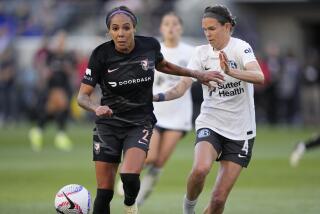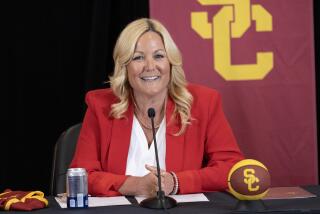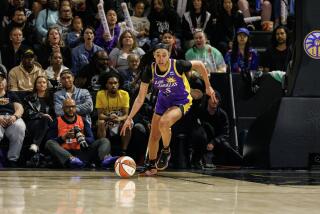Expert Says Deal Is Good for the NHL
The NHL’s adoption of a hard salary cap linked to 54% of league-wide revenues, tight entry-level salary limits and other cost controls in the soon-to-be-finished collective bargaining agreement will give the league a solid economic base and enhance its competitiveness by putting teams on a closer footing, a prominent sports marketing expert said Thursday.
Paul Swangard, managing director of the Warsaw Sports Marketing Center at the University of Oregon and an avid hockey fan since childhood, said the foundation of the labor agreement as outlined in The Times on Wednesday “is the economic model we’ve all believed was needed, those of us who follow this as a business. It sets the league up to be successful in the only way it could be successful.”
However, he said that the NHL might be miscalculating if it bases its $37-million salary cap, $24-million payroll minimum and other provisions on projected revenues of $1.8 billion. The league had revenues of $2.1 billion in 2002-03 but has since lost its TV deal with ABC/ESPN and is likely to lose sponsors because of the lockout imposed by Commissioner Gary Bettman last Sept. 15.
“The idea of $1.8 billion seems ambitious,” Swangard said. “Is it impossible? No. It’s not a number that you laugh at. But you sort of worry that it’s going to be ambitious. The silver lining is teams will have the ability to tie personnel expenditures to whatever that number will be....
“The NHL was perceived as one of the mansions of professional sport but in truth, it was lying on a fault line. Hockey needs to grow to be the sport it always wanted to be, and this is the framework that will allow it to do that.”
A prominent agent said that while it will take time for agents, general managers and players to adapt to the new economic system, he expects the deal will be workable.
“If what we’re hearing is right, this will be OK,” the agent said. “We’re not rolling over and dying. We’ll be able to survive.”
Sources familiar with the negotiations told The Times that the NHL and the players’ association had agreed in principle on a labor pact that would for the first time institute sweeping cost controls, which the league had sought after contending player costs had consumed as much as 76% of its revenues.
Revenue sharing will be introduced by having the top 10 revenue-earning teams contribute to a pool from which the bottom-10 can draw. Existing contracts and qualifying offers will be cut by 24%, and players will place 15% of their salary each season into an escrow account until league revenues are calculated. If spending on salaries exceeds 54%, the difference will be paid to the teams; if it’s less than 54%, the money will go back to players.
The lottery for this year’s entry draft will give every team at least one chance at the No. 1 pick, Sidney Crosby. Teams that missed the playoffs each of the previous three seasons will have three chances, a source said.
The disposition of 2004-05 contracts, which had been a major point of contention, will be resolved in the league’s favor, another source said. About a dozen items remain in flux because of disputed language, but those will not derail the talks.
The league and the union, which met on Thursday in New York, separately denied that an agreement in principle had been reached. Nonetheless, several sources said that negotiations will end today or Saturday and that the NHL’s executive committee will review the documents on Monday in New York before passing them to the Board of Governors for a vote late next week. The union is expected to debate and vote after that.
Swangard predicted the reborn NHL will be more appealing than the pre-lockout version.
“I absolutely believe this framework is going to make it exciting,” he said. “On any night a fan can go to an arena and see an entertaining game with a win or a loss and at a reasonable price....
“The other benefit of this economic model is I think it makes the sponsors happy. Other leagues, such as the NFL and AVP, rely on sponsors to promote the sport, and when the business is in a better state of affairs sponsors are more willing to invest dollars.”
Times staff writer Chris Foster contributed to this report.
More to Read
Go beyond the scoreboard
Get the latest on L.A.'s teams in the daily Sports Report newsletter.
You may occasionally receive promotional content from the Los Angeles Times.







